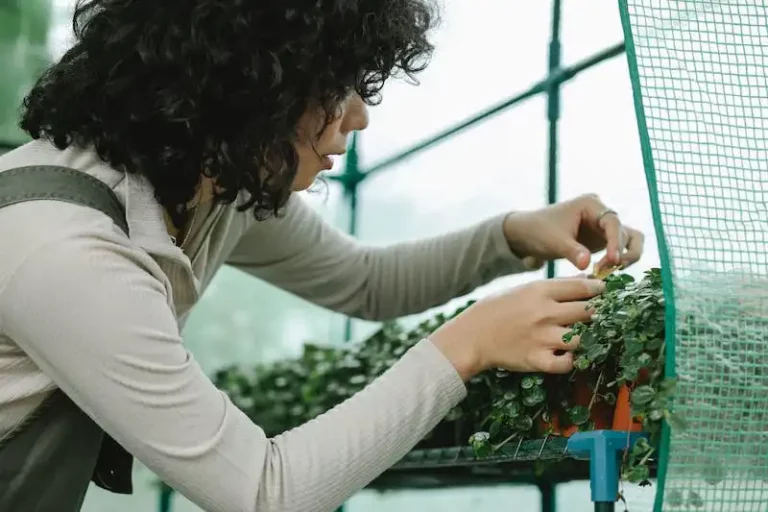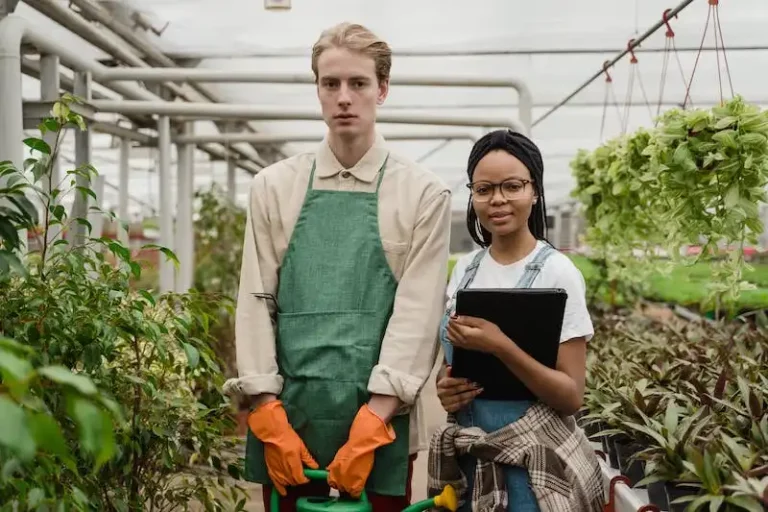Gardenias are beautiful plants that thrive in warm temperatures, making them perfect for indoor gardening. However, they can be a bit finicky and require special care to keep them healthy and blooming. Here are some essential tips for keeping your indoor gardenia flourishing:
Choose the right location: Gardenias need a bright but indirect light location, such as a north-facing window or a spot with filtered sunlight. Direct sunlight can scorch the leaves, so be careful with the placement of your plant.
Always use well-draining soil: Gardenias prefer slightly acidic soil with good drainage. The pot you choose should have drainage holes to prevent waterlogging, which can cause root rot.
Water your plant carefully: Gardenias like to be kept moist but not overly saturated. Water the plant when the top inch of soil feels dry to the touch. The frequency may vary depending on the temperature and humidity levels in your home.
Watch out for overwatering: Gardenias are sensitive to overwatering. If the leaves start turning yellow or drooping, you might be watering too much. Allow the soil to dry out slightly between waterings to prevent root rot.
Feed your gardenia regularly: During the growing season, which is usually spring and summer, it’s essential to feed your gardenia every two to three weeks with a fertilizer specifically designed for acid-loving plants. This will help promote healthy growth and beautiful floral buds.
Provide the right temperature and humidity: Gardenias prefer moderate to warm temperatures, ideally between 65-75 degrees Fahrenheit (18-24 degrees Celsius). They also like a higher humidity level, so consider using a humidifier or placing the pot on a tray filled with water and pebbles to create a more humid environment.
Prune your gardenia: Pruning your gardenia regularly helps to maintain its shape and promote new growth. It’s best to prune in the early spring or right after it blooms. Remove any dead, damaged, or overgrown branches to encourage optimal growth.
Prevent pests and diseases: Gardenias are susceptible to common houseplant pests like aphids and mealybugs. Keep a close eye on your plant and take immediate action if you notice any signs of infestation. Additionally, ensure good airflow by circulating the air around the plant, as stagnant air can lead to mold or mildew.
Repot your gardenia: If your gardenia has outgrown its current pot or if the soil has become compacted, it’s time to repot. Choose a slightly larger pot with good drainage and use fresh potting soil. Repotting is best done in the spring, just before the active growing season.
Propagate your gardenia: If you want to grow more gardenias, you can propagate them from stem cuttings. Take a 3-4 inch cutting from a healthy, non-flowering stem and remove the lower leaves. Dip the cut end in rooting hormone and plant it in a small pot filled with moist soil. Place the pot in a warm, bright location and keep the soil consistently moist. Within a few weeks, the cutting should start rooting and eventually grow into a new plant.
With their stunning blooms and heavenly fragrance, gardenias can bring a touch of elegance to any indoor space. By following these care tips and giving your plant the attention it needs, you can enjoy the beauty of gardenias year-round.
Gardenia Indoors Gardenia jasminoides
Gardenia jasminoides, commonly known as gardenia, is a beautiful flowering plant that can be grown indoors. With its fragrant white flowers and glossy leaves, it adds beauty and elegance to any room. However, caring for gardenia plants indoor can be a bit challenging, as they have specific needs and require proper care.
To keep your gardenia plant healthy and thriving, there are a few key tips to follow. First, it’s important to provide the right amount of light. Gardenias need bright, indirect light to thrive. Placing them near a window where they’ll receive morning sunlight is ideal.
Gardenia plants are also quite particular about their humidity levels. They thrive in high humidity, so misting the leaves regularly or using a humidifier in the room can help maintain the necessary moisture. Additionally, it’s important to avoid placing the plant near heating or cooling vents, as the dry air can cause the leaves to wilt.
When it comes to watering your gardenia, it’s important to strike a balance. Overwatering can lead to fungal problems and root rot, while underwatering can cause the plant to wilt. Water the plant thoroughly when the top inch of soil feels dry to the touch, and make sure the pot has good drainage.
Feeding your gardenia plant is another important aspect of care. Gardenias are heavy feeders and benefit from regular feeding. Use a slow-release, balanced fertilizer specifically formulated for acid-loving plants. Follow the instructions on the fertilizer package for the best results.
Gardenias are also susceptible to pests, such as whiteflies. Keep an eye out for any signs of pests and take action if you spot any. You can use insecticidal soap or other organic pest control methods to get rid of them.
Repotting your gardenia plant is necessary every year or two, depending on its growth. When repotting, use a well-drained potting mix that is formulated for acid-loving plants. Make sure the new pot is slightly larger than the old one to accommodate the growing roots.
Another key tip is to prune your gardenia to encourage bushier growth and more flowering buds. Prune the plant after the blooming period to shape it and remove any dead or diseased wood.
In recent years, gardenia plants have become popular companions with other indoor plants. Monstera deliciosa, pothos, and Ceropegia woodii are some plants that are often grown together with gardenias. This not only enhances the beauty of the display but also creates a more balanced and harmonious growing environment.
In conclusion, caring for a gardenia jasminoides plant indoors requires attention to detail and understanding of its specific needs. By providing proper light, humidity, watering, feeding, and pruning, you’ll be rewarded with a gorgeous and healthy plant that brings joy to any room.
Indoor Gardenia Care Tips
Gardenias are beautiful flowering plants that can be grown indoors. However, they require proper care to thrive and produce blooms. Here are some tips for caring for indoor gardenias:
- Light: Gardenias prefer bright, indirect light. Place them near a window where they can receive plenty of light, but avoid direct sunlight.
- Temperature: Gardenias like warm temperatures between 65°F and 75°F (18°C – 24°C). Avoid exposing them to extreme temperature fluctuations.
- Humidity: Gardenias love high humidity. You can increase humidity by placing a tray of water near the plant or using a humidifier. Misting the foliage regularly can also help.
- Watering: Keep the soil consistently moist, but not waterlogged. Water thoroughly when the top inch of soil feels dry. Avoid overwatering, as it can cause root rot.
- Soil: Use a well-draining potting mix that is rich in organic matter. Adding sand or perlite to the soil can improve drainage.
- Fertilizer: Feed your gardenia plant with a balanced, slow-release fertilizer formulated for acid-loving plants. Follow the instructions on the packaging for dosage and frequency.
- Pruning: Prune your gardenia plant regularly to maintain its shape and promote flowering. Remove any dead or diseased branches and trim back long, leggy stems.
- Pest control: Keep an eye out for common pests like whiteflies and aphids. If you notice any infestations, treat them promptly with insecticidal soap or neem oil.
- Blooming: Gardenias typically bloom in the spring and summer. If your indoor gardenia isn’t flowering, it might be due to insufficient light, improper temperature or humidity, or lack of nutrients. Check the growing conditions and make necessary adjustments.
- Propagation: You can propagate gardenias through stem cuttings. Take a 4-6 inch cutting from a healthy, non-flowering stem, remove the lower leaves, dip the cut end in rooting hormone, and plant it in a pot with a well-draining soil mix. Keep the soil moist and provide bright, indirect light. The cutting should root and start growing within a few weeks.
- Bonsai: Gardenias can be trained into bonsai trees. They have small, shiny leaves that are ideal for bonsai cultivation. Choose a young gardenia plant with a straight trunk and prune it regularly to shape it into a bonsai tree.
With the right care and conditions, indoor gardenias can be a beautiful addition to your indoor gardening collection. Follow these tips to keep your gardenias healthy and blooming.
Gardenia Care Solutions and Special Helps
When it comes to caring for indoor gardenias, there are a few solutions and special helps that can ensure your plants thrive in any environment.
First, it is important to consider the morning sunlight. Gardenias prefer bright but indirect light, so placing them in a location where they can receive a few hours of morning sun is ideal. However, avoid exposing them to direct sunlight during the hotter hours of the day, as this can burn their leaves.
Gardenias also thrive in warm temperatures. Ideally, keep your indoor gardenia in a location that maintains a temperature between 65-75°F (18-24°C) during the day and around 60°F (15°C) at night. This will help promote healthy growth and beautiful blooms.
Another crucial factor for gardenia care is humidity. Gardenias are native to warm, humid conditions, so replicating these conditions indoors is essential. You can increase the humidity around your gardenia by placing a tray filled with water near the plant or using a humidifier. This will help to keep the leaves glossy and prevent them from drying out.
When it comes to watering, gardenias prefer moist but not waterlogged soil. It is best to water your gardenia when the top inch of soil feels dry to the touch. Be sure to water your gardenia thoroughly, allowing the water to fully saturate the root system. Avoid getting water on the leaves, as this can lead to fungal issues. Watering from the base of the plant is recommended.
As for fertilizing your gardenia plant, it is important to use a fertilizer specifically formulated for acid-loving plants. Opt for a slow-release fertilizer and follow the instructions on the packaging for application frequency. Fertilizing your gardenia from early spring to early fall will help promote healthy growth and abundant flowering.
If you notice any issues with your indoor gardenia, such as yellowing leaves, it is important to identify the cause and take appropriate action. Yellowing leaves can be caused by various factors, including nutrient deficiencies, overwatering, or pests. Check for signs of pests, such as spider mites, and treat accordingly. Adjusting the watering schedule or providing the necessary nutrients can also help resolve yellowing leaves.
Repotting your gardenia may be necessary if you notice that the root system has outgrown its container. Choose a pot that is slightly larger than the current one and use a well-draining soil mix. Be careful when handling the fragile roots and try to disturb them as little as possible. Repotting your gardenia during the spring or early summer when it is actively growing is ideal.
In addition to the care tips mentioned above, consider taking your gardenia outdoors during the summer months. This will allow the plant to benefit from natural sunlight and fresh air. However, be cautious of extreme temperatures and make sure to gradually acclimate the plant to the outdoor conditions to prevent shock.
In summary, providing the right conditions and care for your indoor gardenia will help it thrive and produce beautiful flowers. Paying attention to factors such as sunlight, temperatures, humidity, watering, fertilizing, and pest control will ensure a healthy and vibrant gardenia plant that will enhance any indoor space.


